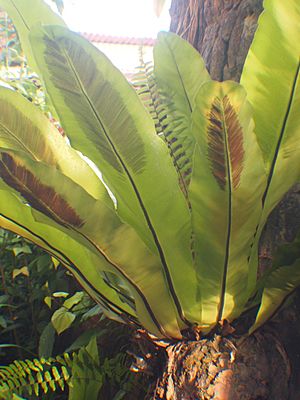Asplenium nidus facts for kids
- Asplenium nidus is a type of fern often called the bird's-nest fern or simply nest fern. It grows on other plants, like trees, but it is not a parasite. This fern is found in warm, tropical places. These include parts of southeastern Asia, eastern Australia, Hawaii, Polynesia, Christmas Island, India, and eastern Africa.
Quick facts for kids Asplenium nidus |
|
|---|---|
 |
|
| Conservation status | |
| Scientific classification | |
| Genus: |
Asplenium
|
| Species: |
nidus
|
| Synonyms | |
|
|
Contents
What it Looks Like
Asplenium nidus has large, simple leaves called fronds. These fronds look a bit like banana leaves. They can grow very long, from about 50 to 150 centimeters (20 to 59 inches). They are also quite wide, about 10 to 20 centimeters (4 to 8 inches) across.
The fronds are light green and often have a crinkled look. They have a black line down the middle, which is called the midrib. When new fronds grow, they unroll in a special way, like a fiddlehead.
Tiny spores grow in small clusters called sori. These sori are found on the underside of the fronds. They form long rows that stretch out from the midrib. As the fronds get old and turn brown, they curl back. This creates a large "nest" of leaves in the trees where the fern grows.
How it is Grouped
Scientists group living things based on how they are related. Asplenium nidus belongs to a group of ferns called the "Neottopteris clade." Ferns in this group often have somewhat leathery leaves.
Many ferns in this group look like "bird's-nest ferns." They have whole leaves and veins that join together near the edges. Scientists have found that not all A. nidus plants are exactly the same. For example, A. nidus from Madagascar might be different from those in New Guinea. This means more study is needed to understand all the types.
A. nidus is closely related to Asplenium australasicum. This fern looks very similar. However, other bird's-nest ferns, like Asplenium antiquum and Asplenium phyllitidis, are not as closely related.
Where it Grows Naturally
Asplenium nidus grows naturally in many warm places.
- Africa: East tropical Africa, including the Zanzibar Archipelago in Tanzania.
- Asia: Indonesia, East Timor, parts of Japan (Kyushu and Ryukyu Islands), Malaysia, the Philippines, Taiwan, and Thailand.
- Australia: The northern part of Queensland.
Where it Lives
This fern can grow in different ways. It can grow on other plants, like trees. This is called being an epiphyte. It can also grow in the ground, which is called being a terrestrial plant. Most often, it grows on dead leaves and other plant material.
Asplenium nidus often lives in palm trees. It collects water and rich soil (humus) in its leaf "nest." It likes places that are warm and humid. It also prefers partial shade or full shade. Direct sunlight is not good for it. It grows well on a north-facing garden wall where it gets full shade.
How People Use It

People grow Asplenium nidus a lot as a houseplant. It needs a minimum temperature of about 10°C (50°F). Many plants sold in America as A. nidus are actually Asplenium australasicum. This fern has longer sori and a different midrib shape.
Asplenium nidus has won an award called the Royal Horticultural Society's Award of Garden Merit. This award is given to plants that are excellent for gardening.
In some places, people have used Asplenium nidus in traditional medicine. It has been used for things like asthma, sores, feeling weak, and bad breath.
The young shoots of A. nidus are eaten as a vegetable in Taiwan. There, it is called 山蘇 (shān sũ). People usually cut it into small pieces and cook it with garlic and chili peppers.
Protection
In Hong Kong, Asplenium nidus is a protected species. This means it is against the law to harm or remove it. This protection is part of their Forestry Regulations Cap. 96A.
- LORENZI, H.; SOUZA, M.S. (2001) Plantas Ornamentais no Brasil: arbustivas, herbáceas e trepadeiras. Plantarum ISBN: 85-86714-12-7
See also
 In Spanish: Asplenio para niños
In Spanish: Asplenio para niños




